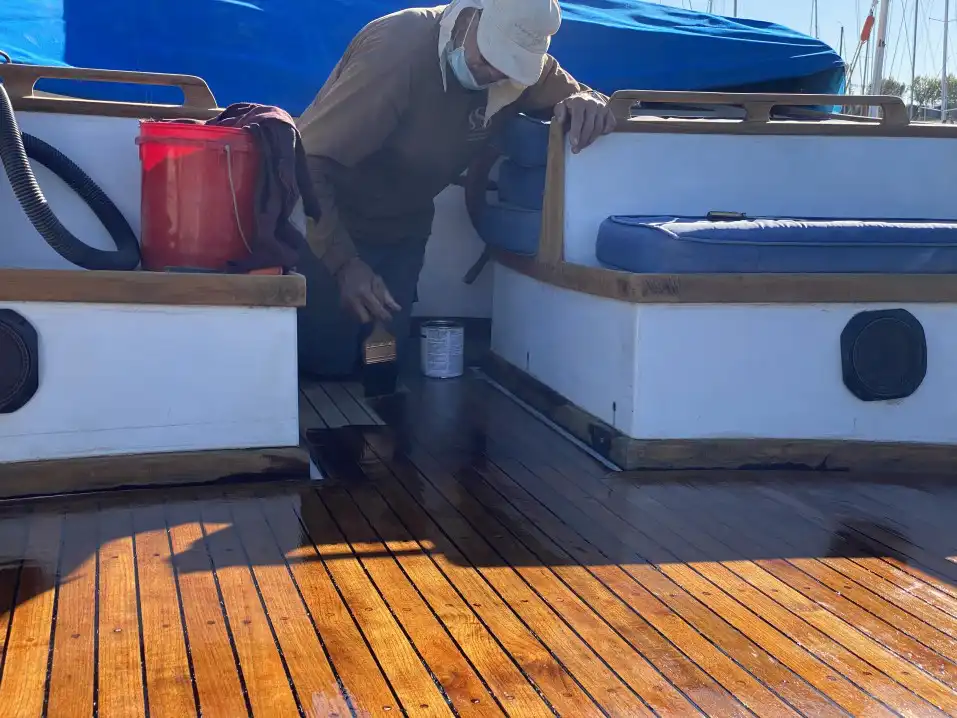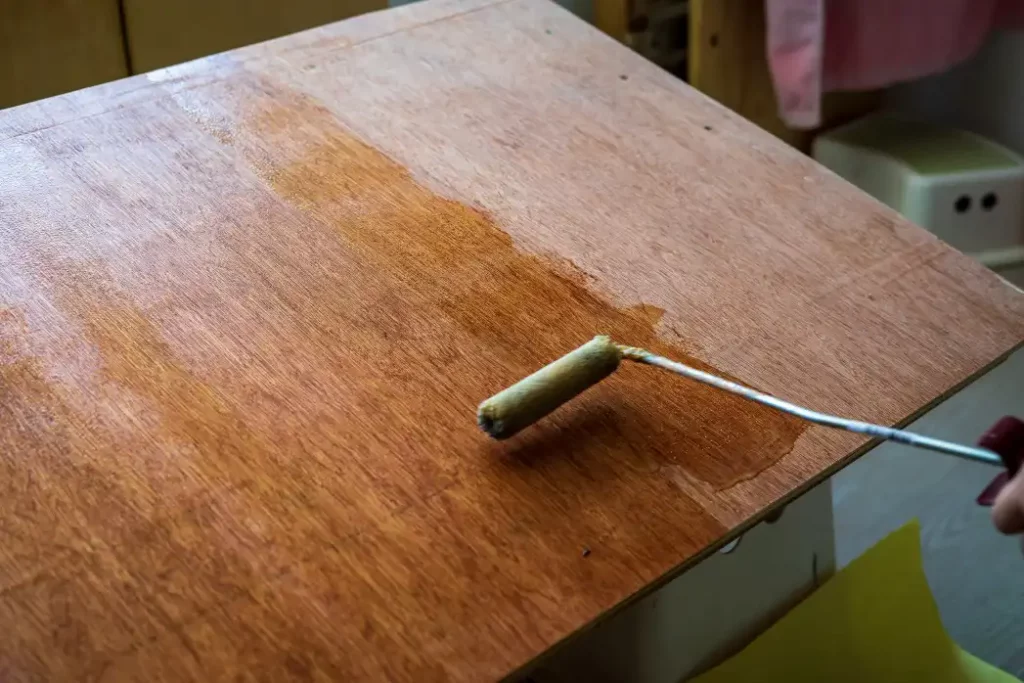Difference between marine varnish and polyurethane
Polyurethane is a water or oil-based polymeric compound used to coat or polish wood. Varnish is an older finish manufactured from resins, oils, and solvents, but it is ideal as a catch-all phrase for all types of wood finishing. The significant distinctions depend on the following factors:
Properties
Polyurethane is rigid and abrasion-resistant, and easy to apply. However, it is vulnerable to UV degradation. Whereas varnish has strong UV protection, is flexible, and has a lovely color.
Wood flooring, bookcases, desks, picture frames, and hardwoods are all made with polyurethane.
On the other hand, the varnish is valuable on outdoor decks and chairs, yachts, and softwoods.
Polyurethane is a relatively durable material; however, it is vulnerable to cracking and UV damage in contrast to varnish, which is slightly less stable but more flexible and resistant to UV damage.

Material for the coating
Polyurethane is a polymeric resin that can originate from water or oil. Resins, oils, and solvents are the essentials that create varnish.
Drying Time
Water-based polyurethane dries quickly, but oil-based polyurethane dries slowly.
On the other hand, varnish takes a long time to dry, taking up to 6 hours under ideal conditions.
You can apply polyurethane with a brush, spray, or wipe-on. One or two coatings are sufficient. Varnishes, too, must be brushed until you reach many layers.
Toxicity
External factors dictate the extent to which polyurethane is poisonous. The toxicity of water-based products is minimal, while oil-based products are more harmful. Varnish is even safer than polyurethane in terms of toxicity.
Price
Polyurethane is typically 10-20% less expensive than varnish for equivalent manufacturers.
Varnish, on the other hand, is less expensive than polyurethane.
Is marine varnish better than polyurethane?
Polyurethane is superior to marine varnish. Polyurethane is commonly suitable for inside household items such as bookshelves and tables, while the varnish is widely ideal for outdoor surfaces like decks. Both provide durability, a variety of color options, and weather resistance. When it comes to finishing your interior hardwood floor, polyurethane is the best choice.
While varnish is helpful for its UV protection and natural durability, it is designed specifically for use on outdoor surfaces. For interior applications, polyurethane, on the other hand, provides durability and flexibility.
Consider the purpose and appearance of the surface when selecting polyurethane for your hardwood floor. If you subject your floor to foot traffic, an oil-based poly is the better option. Water-based poly is a way to go if you want to maintain the wood’s natural beauty but are eager to go with the less durable choice.

Polyurethane is a water- or oil-based polymeric resin, whereas varnish is an older product composed of resins, oils, and solvents. Varnish is less vulnerable to ultraviolet light damage due to its higher solids ratio. Because of this protection, the varnish is a good choice for tasks like outdoor decks and furniture. Nonetheless, varnish, unlike polyurethane, is intended for outdoor projects and is not commonly used on indoor surfaces such as hardwood floors.
Which is more durable, varnish or polyurethane?
The longevity of varnish or polyurethane depends on several elements, including the application location. The program is valuable for a specific floor. Oil-based polyurethane is ideal if it will be subjected to a lot of traffic and wear. Water-based polyurethane will perform nicely in a guest bedroom that you can rarely use.
Polyurethane is a more rigid and more lasting material. It hardens into a protective covering of plastic that resists scratches and abrasion. In comparison to water-based polyurethane, oil-based polyurethane is more durable. However, polyurethane’s firm surface is limited to indoor furniture and permanent furniture placements.
Because of its complex surface, moving the furniture around and subjecting it to the sun reduces its durability. Varnish is less durable than paint, but it is more adaptable and versatile. Because of its UV protection and water resistance, it is more robust on outdoor furniture than polyurethane.
Polyurethane is also a long-lasting finish that can last for years. Oil-based polyurethane wood finishes typically last 10-20 years before needing to be renewed. They are, however, prone to cracking and UV damage. On the other hand, Varnishing lacks the same strength and durability as polyurethane. It usually only lasts a few months, but gloss oil varnish often lasts 10-20 years, although it is more resistant to UV rays.
What is marine varnish suitable for?
Marine varnish is a weather-resistant finish protecting your wood from the sun, rain, wind, sea spray, UV rays, and chemicals. Marine or spar varnishes often come from oil, solvent, resin, UV chemicals, and drying agents.
Marine varnish is a premium external coating developed to give a high-quality, flexible finish resistant to water and elements. Ultraviolet absorbers are also included for added sun protection.
Marine varnish, also known as spar varnish, is typically applied to both the inside and outside of a boat to provide a nice glossy surface, endurance in various weather conditions, maximum water resistance, and UV protection.
The marine spar varnish serves as an excellent example. System Three Marine Spar Varnish is a high-build coating for marine epoxy and exterior wood surfaces like railings and doors and any other surface that requires a clear, long-lasting gloss finish.
System Three Marine Spar Varnish incorporates cutting-edge UV absorbers that keep wood looking great even when exposed to direct sunshine regularly. Scratching and marring and numerous cleaners and solvents are resistant to System Three Marine Spar Varnish.
Is polyurethane the same as varnish?
Polyurethane and conventional varnish are two popular finishes that, when applied, cure into durable protective layers. Even though you can sometimes interchangeably use them, each one serves a different purpose and provides different levels of protection from the weather.
Polyurethane is a wood finish, primarily a plastic resin that hardens when applied to the surface. It is available in both oil and water-based versions. It is not to be confused with varnish. Varnish usually comes from resin, solvent, and oil. It’s a natural wood finish best used on outdoor furniture because of its UV and water resistance. Between oil-based and water-based polyurethane is water-based oil-modified polyurethane.
Compared to water-based polyurethane, water-based oil-modified polyurethane provides more strong protection and a longer-lasting surface. Even though it is more hazardous, oil-based polyurethane is more robust and provides superior protection for woods.
When compared to polyurethane, the varnish is less hazardous. Both water-based polyurethane and varnish are more dangerous than oil-based polyurethane. Polyurethane is more durable; however, UV light or water can damage it. Varnish is less stable, but it lasts longer when exposed to UV rays and water. Because varnish is thinner, apply it with a brush and multiple coats. Because polyurethane is thicker, it is used by wiping, brushing, or spraying it in a few coats.
- Pyrography Techniques for Beginners: Textures and Shading - January 23, 2024
- Troubleshooting Jointer Issues: Why is Your Jointer Not Flattening Wood? - October 11, 2023
- Unlocking the Secrets of Jointing to Increase Width - September 29, 2023
